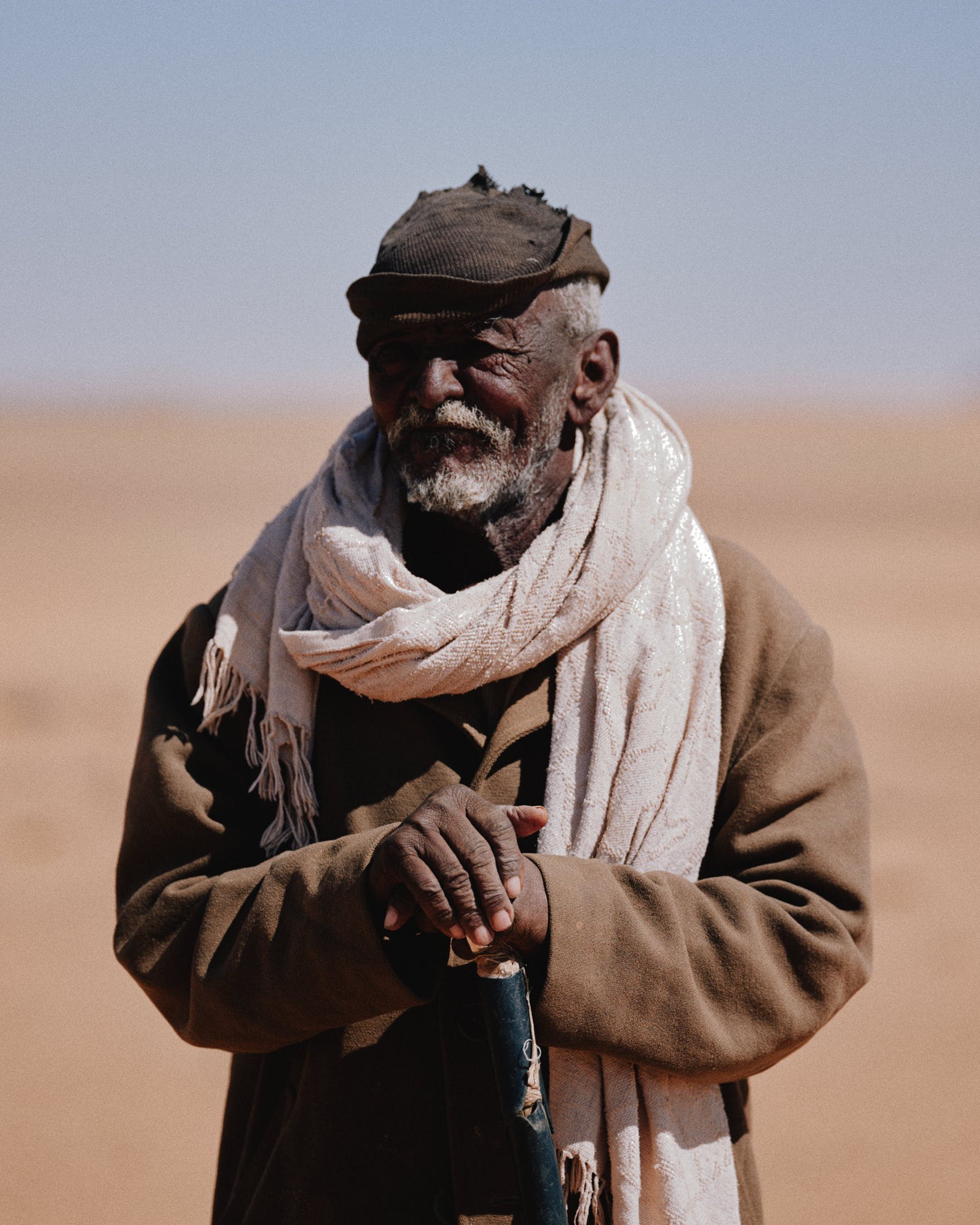Life at the Speed of a Camel
CROSSING THE SUDAN’S BAYUDA DESERT
Read time 10 mins
I had long dreamed of crossing a desert by camel, probably because I watched the film Lawrence of Arabia too many times as a child. Though most desert adventurers now use Toyota 4x4s, this romantic vision of slow desert travel still holds an allure.
Wilfred Thesiger wrote about “having the man’s courage to live out the boy’s dream.” In early 2020, I did just that.
Read the story below:
As the shadows of the afternoon lengthen over the desert floor, Qatar – one of our Bedouin guides – starts to sing. His tenor voice booms into the silence, interrupting himself with guttural shouts of “heh!” and “huh!” when he spies a camel going off route.
I spur my camel on to stay within earshot. We ride through a wind-scoured wasteland of rock and gravel, then on through sensual waves of sand. Atop a camel, I am seduced by the romance of desert travel, surrounded by thrilling emptiness; the hypnotic pad of my camel's feet; the vast dutch blue sky.
On the map, the Bayuda Desert curls into a giant 600km bend in the Nile like a giant camel's ear. At its southern-most tip lie the Meroe pyramids, marking the southern half of Nubia – the cradle of one of the world’s first civilisations. It is also home to several Bedouin tribes. Our route follows their 280km ancient trade route – from Shendy to Korti – and for ten days we belong to an older, slower world.
We camp near a solitary Acacia tree, where our camels gather, craning their necks to reach the juiciest leaves. We join the camel herders by a fire teased from three sticks of wood. They offer us ‘Shai’ (tea) in enamel mugs brewed in a time blackened pot. We watch as they bake bread on the fire, mixing it up with a rich salad and eating communally from one bowl. Night comes quickly; we retire to our tents while they curl up in the open under thick blankets. The sky is thick with stars, extending to the very bottom of the horizon.
We rise when the horizon glows orange and breakfast as the sun emerges. Bela – our chief guide – hovers over us, shouting “Yallah!” (let's go!), as Qatar whips the breakfast rug from underneath us. Bela takes his responsibility of getting five ‘Khawajas’ (foreigners) across this unforgiving landscape seriously. With our camels loaded we set off into the silent embrace of the Bayuda.
Camel saddle design is (thankfully) unchanged since ancient times so my western bottom has to adapt. I study how my Bedouin companions ride – crossed legs to one side, taking weight on the thighs, not the delicate bits. The initial first few days of agony giving way to ‘semi-comfort’.
Slow travel reveals the wonders of the Bayuda Desert – wild baby camels wander up to us, whirlwinds of sand suddenly appear and take off across the landscape. Luscious but poisonous fruit (Citrullus Colocynthis) lie scattered around the desert floor. Tiny mice take sanctuary in the shadows of our feet as we walk.
Not a drop of water has touched our camel's lips for 5 days when we arrive at Jakdal wells – a remote watering hole that marks the half-way point of our route. To our astonishment, they take only a few sips of water then wander off. Some do not drink at all. “It’s winter, they are not thirsty” Bela explains nonchalantly. In the Sudan, ‘Winter’ is a balmy 25 degrees.
The Bayuda plays host to a Biblical cast of characters; goat herders; barefoot wanderers on camels; father and son on mournful donkeys; shepherds searching for lost flocks. Some pass by as distant figures wandering the wilderness. When others pass close enough to exchange an ‘As-salamu alaykum’ it becomes a cause for celebration – good fortune to have run into one another in all this emptiness.
On our final night in the Bayuda, Qatar tells me that ‘when Allah made the world he gave the empty places to the Bedouin, we are lucky’. Three visitors arrive in a Toyota pickup truck. Our Bedouin companions greet them like long lost friends and make ‘Shai’ around the fire. I wander off to take one last gulp of silence – it’s total here, swallowing the voices from the campfire with ease. It’s at this moment I know I will return to the desert – for that supremely satisfying sensation of freedom that is unattainable in modern civilisation.
Photography Notes: Fuji GFX 50RPostscript – Just a few months after this trip, the pandemic brought travel to a screeching halt – a reminder that the time to live our travel dreams is now.
As I write this, war has come to the Sudan. I can only hope that Belah, Qatar, and rest of the crew that I shared this journey with are safe.
PRACTICALITIES
As travel to the Sudan is not possible now here are some alternatives for those interested in experiencing desert travel by camel.
ALGERIA – it is possible to arrange camel treks in the Tassili N'Ajjer National Park in the Algerian Sahara. While travelling there in 2022, I met a group on a trek with Tinariwen Tours.
EGYPT – Operators such as 360 Expeditions run multi-day camel treks in the Sinai Desert.
MOROCCO – Southern Morocco is a well–known destination for those wanting a short taste of desert travel by Camel. There are numerous companies offering Camel treks.
Disclaimer: I have not travelled with, and have no affiliation with the companies mentioned above.
You might also like









































